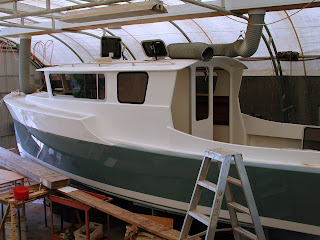
Vessel is nearing completion and is ready for your personal customization and diesel engine choice.
Innovative lightweight cruising Trailer Trawler with traditional appearance built using modern materials and construction techniques.



Click on pictures to view construction sequence and teak deck procedure
Specification
- Length: 7.6 meters
- Width: 2.5 meter
- Weight: less than 2000 Kg
- Motoring Speed: 6-9 Knots
- Trailer able - Extended choice of cruising grounds (Choose the entire coastline of Australia as your cruising ground using the highway instead of holiday consuming ocean passages)
- Lightweight advanced construction allows vessel to be towed by large family vehicle (not a dedicated towing vehicle).
- Use as conventional caravan during land based travels and camping, beside a lake or up a river !!
- Water ballasted for stability at sea and lightness while trailering
- Store and work on the boat on land, cutting slippage and anti-fouling maintenance costs.
- Displacement hull matched with lower horsepower fuel efficient diesel engine for dramatically reduced fuel costs and extended range.
- Fully fitted for extended voyaging on land, sea, lake or river
Galley with 100 liter drawer type refrigeration, gas cooker top, sink and pressure water
Separate compartment, electric head and shower with holding tank.
Construction
- Entirely built from epoxy vinylester resin for elimination of osmotic blistering
- All laminates used are non-woven stitched fabric orientated for strength.
- Kevlar in laminate in fwd sections below w/l
- Hull, deck, cabin and cockpit construction with Divinycell H80 Core
- No heavy chop strand mat!! No useless chopper gun layup!!
 |
| Construction Photo Album |
